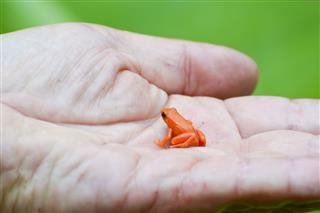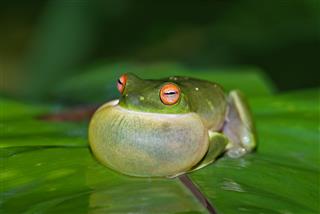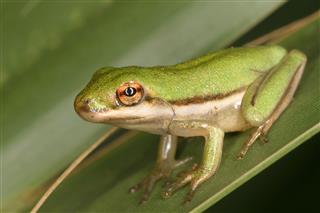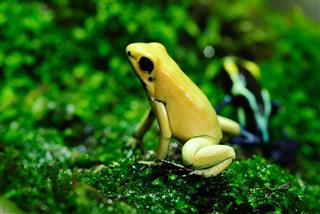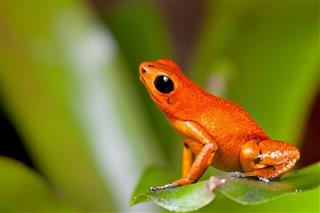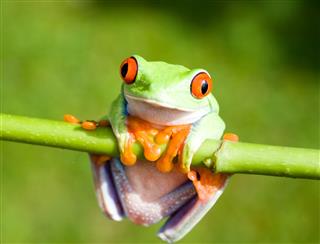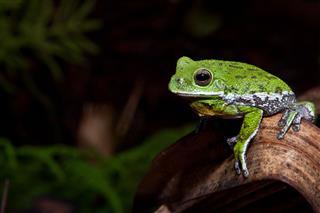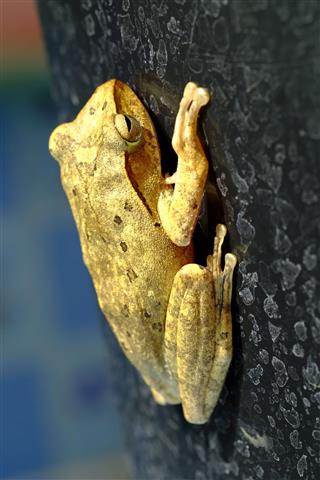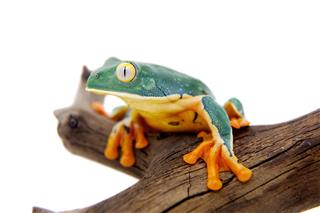
As the name rightly suggests, tree frogs spend most of their life on trees and tall vegetation. Go through this article for a brief overview of tree frog diet.
Popular as exotic pets, tree frogs are preferred for their small size and colorful appearance. There are numerous species of tree frogs, that belong to families, like Rhacophoridae, Hylidae, Centrolenidae, and Hyperoliidae. Certain genera, like Boophis of the family Mantellidae and Pedostibes of the family Bufonidae, do have some tree frog species. Frogs that belong to the family Hylidae are often referred to as true tree frogs, but it has some terrestrial or semi-aquatic species too. Irrespective of the family and genera, most of the tree frogs inhabit trees and tall shrubs located near still-water sources.
Tree frogs come in different colors that range between green, brown, gray, or a mix of bright colors. It has been observed that most of the bright-colored tree frogs are toxic. Some of them have the ability to change the body color for camouflaging purposes. Lines, spots, and other designs may also be seen on their body. Their body length may vary between 1 to 5.5 inches, and they may weigh between 2 to 17 gm. These frogs may live around two to four years and more. Tree frogs are well adapted to arboreal life, as they have strong and long legs that enable them to jump and climb. They have adhesive toe pads, that are used to cling to the stems, branches, and leaves. Their big, round, and protruding eyes provide them with binocular vision. Tree frogs have sticky tongues that are used to catch their prey.
Tree Frog Diet
Tree frogs are mostly nocturnal, but they may hunt during daytime, if they feel really hungry. Though their diet may slightly vary with different species and geographic locations, in general, tree frogs are carnivorous in nature. Their diet consists of insects, worms, and small invertebrates. It has also been observed that some species, especially the larger ones, feed on small mammals, other frogs, and small fish. The Cuban tree frog, which is the largest tree frog of North America, is known for its feeding habits. Being excellent climbers, they can hunt and feed on a wide variety of prey, like insects, snails, spiders, snakes, lizards, other frogs, crustaceans, bird hatchlings, etc.


Food for Tree Frogs in Captivity
Most of these frogs are attractive in appearance and docile in nature. Some species are very popular as exotic pets. The most popular among them are green tree frogs, especially, the American green tree frog, the Australian green tree frog, and the red-eyed ones. Though it may appear easy to keep a tree frog as a pet, you must have a thorough knowledge about the various aspects of frog care. Their requirements may vary with different species and size.
When it comes to the diet of pet tree frogs, you must have a supply of live crickets, flies, and meal worms. As mentioned above, you have to cater to their individualized requirements. Green tree frogs feed on crickets, earthworms, and meal worms, whereas Pacific tree frogs like spiders, beetles, flies, and ants. In general, it can be said that tree frogs feed on insects (especially, gut-loaded crickets) and worms. Make sure that the size of the prey is in accordance with the size of the frog.
For juveniles, you may use flies, moths, cockroaches, etc., as food, that can be fed daily. Adults frogs must be fed two to three times a week. You may provide them with two to four small crickets every alternate day. Dust the prey with calcium and multivitamin powder, before you feed the frog. Mist the frog with water (without chlorine), once a day, preferably during morning. A separate enclosure for feeding is also advisable. In case of a pet tree frog, food (like live crickets) can be obtained from the pet store itself. For tadpoles, algae and pond plants are given as food, but they turn carnivorous as they grow up. Tadpoles of these frogs can also be fed with pieces of boiled lettuce leaves.

As mentioned above, frogs hunt for prey with their tongue stuck out. They feed on insects, like moths and flies that stick to their tongue. Though they wait passively for the prey to get stuck, sometimes they may leap or jump to catch their prey. Large frogs are found to pounce on smaller prey. Frogs swallow their food, as their teeth are not fit for cutting or chewing. As pets, tree frogs may like to hunt live insects. However, babies have to be fed. All you have to do is to feed them regularly and consistently, but overfeeding must be avoided. You can get more information about the feeding habits of the specific tree frog from pet shops.


